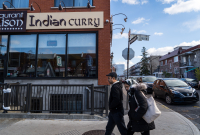Support strong Canadian climate journalism for 2025
This story was originally published by City Lab and appears here as part of the Climate Desk collaboration.
In his 65 years, Denis Bédard has watched a city grow up around his Quebec City family farm.
Beauport used to be a rural area home to dozens of vegetable farmers. “There was no urbanization at all,” says Bédard, owner of Ferme Bédard et Blouin. “The 1960s is when it all started.”
That’s when developers began snapping up lands owned by aging farmers. In the decades that followed, Quebec City sprawled into Beauport. More buildings sprang up. Traffic clogged the main street. The number of farms dwindled. But there were always a few holdouts that anchored the area in its agricultural roots, chief among them a congregation of nuns called les Soeurs de la Charité (Sisters of Charity). The sisters owned 500 acres of land that, for more than 100 years, was used primarily for grain and seed production.
That is, until 2014, when the nuns sold their land for an astronomical $39 million (plus $14 million in built-in interest) to Michel Dallaire, a private developer who intends to use part of the land to build 6,500 housing units—many of them single-family homes and townhouses. The city, which is in the process of creating a new urban development plan, has endorsed the Beauport project and is working with Dallaire’s company, Groupe Dallaire, to make it happen.
“That was the trigger,” says Monique Gagnon, spokesperson for Voix Citoyenne (“Citizens’ Voice”), a grassroots advocacy group opposed to housing development on these lands. The city has since used the Dallaire opportunity to request the dezoning of at least 1,000 acres of agricultural land in Beauport and another 400 acres west of the city, in St-Augustin, in order to grow its urban perimeter.
Beauport ‘a hole that must be filled’
Quebec City, metro population 800,000, believes that it will need an additional 28,200 households between now and 2036 if it wants to keep pace with divorce rates and immigration. This oft-cited figure is fundamental to the reasoning for the Beauport project—but it’s only part of the story.
With 382,000 existing housing units, Quebec City actually has an oversupply of housing—particularly condos—which has caused real estate prices to stagnate in recent years. It also has a low birth rate and an aging population. “We’re probably at the end of strong growth, and are probably going toward stagnation or small growth unless there’s massive immigration,” says Érick Rivard, an architect, urban designer, and university professor based in Quebec City.
With a population density of just 608 people per-square-mile, the city also has a notable sprawl problem (for reference, New York City has a density of 27,000 people per-square-mile). The city’s proposed urban development plan looks to maintain this land-use ratio, and it has every incentive to do so. Because the city gets most of its money from property taxes, the more high-value real estate development it greenlights the easier it is to fill its coffers.
But many Quebec City residents aren’t interested in more low-density housing. “Everything here is built for the car. Outside of the old city’s downtown, there’s no neighborhood life,” says Gagnon of Voix Citoyenne. “They have an opportunity right now to reimagine the city, and they’re looking at it through a 1960s lens.”
When contacted for this article, a city spokesperson said it is trying to find “a balance” between its plans and citizens’ concerns. Still, by its own estimate in the urban development plan, if the city simply densified some already-developed areas it would be able to completely spare its agricultural lands and meet housing needs.
Of course, this approach is significantly more difficult and less lucrative than building on top of agricultural land, says Rivard. That’s what makes places like Beauport so attractive to real estate developers. “The developer’s perception is that this virgin land surrounded by suburbs is like a hole that absolutely must be filled,” he says.
Quebec City runs into dezoning roadblocks
For context, Dallaire has development projects all over Quebec City, including a controversial condo tower. The deal he made with the Soeurs de la Charité is also controversial—and a bit complicated.
He bought the land from the nuns on a 10-year payment plan by way of an organization called Société en commandite Terres d'espérance (which is also a registered lobby group), with the original intent of casting it as a philanthropic project. Profits generated by the development—estimated at $150 million—would be split between his own family’s charitable foundation and that of the sisters. Note that Canada has a number of tax breaks and exemptions for both charities and agricultural activities.
Getting some of the agricultural lots dezoned is key to the Beauport plan. But in order for Quebec City to get part of the Beauport agricultural lands rezoned for housing, it needs to get permission from the provincial government, which has strict rules for protecting agricultural land. One of the strictest rules generally prohibits parcelling large agricultural plots, because it makes it easier to open the land up to future real-estate development. Dallaire’s lobbyist file targets the agencies responsible for protecting the land.
The first attempt at dezoning Beauport didn’t go well. In August, the city submitted its new urban development plan to the province. The province rejected it in October, telling Mayor Régis Labeaume to do better with respect to protection and enhancement of the land. The city now has until mid-February to present its new plan.
The fight continues
The rejection was a small victory for Bédard, Gagnon, and other opponents of the Beauport plan—but it may just be a matter of time before some version of the project is approved. Groupe Dallaire announced that it was going back to the drawing board to create a “greener” proposal that better integrates agriculture.
Farmer Bédard intends to keep fighting.
His farm, Bédard et Blouin, borders the plots in question. He’s got 358 acres of land, some of it previously purchased from the nuns for a fraction of the $39 million Dallaire paid. Only a third of Bédard’s land is farmed; the rest is wooded.
Shortly after the project’s 2014 announcement, Bédard wrote an impassioned plea in the Le Soleil newspaper suggesting the province create a protected greenbelt with the Beauport lands, including his own. In his letter, he reminded readers that whatever agricultural land remains in Quebec will become critical for future food production. “Did you know that it takes 5,000 to 7,000 years to create the 40 centimeters of arable soil we’re about to sacrifice?” he demanded.
While a soil specialist contacted for this article couldn’t confirm his statement because she wasn’t familiar with the plots’ geographic and environmental conditions, she did say real-estate development would likely compromise the land’s ability to perform carbon sequestration and water filtration. Environmental functions like these are necessary to mitigate climate change.
“We see it everywhere in the world, where cities are fighting to keep their green spaces and create new ones,” says Bédard. Developing agricultural lands like Beauport will destroy their potential for future agricultural use, he notes. “They can’t say, ‘we’ll take it for a few years.’ Once you develop it, it’s gone for good.”






Comments